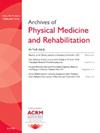Creative Arts Therapies in Rehabilitation
IF 3.6
2区 医学
Q1 REHABILITATION
Archives of physical medicine and rehabilitation
Pub Date : 2025-01-01
DOI:10.1016/j.apmr.2024.07.008
引用次数: 0
Abstract
Appreciation for the utility of creative arts therapy in rehabilitation is on the rise. The limitations of conventional approaches to address posttraumatic stress disorder and co-occurring traumatic brain injury is spurring the development and increased use of creative arts therapies, especially in US military health care systems. However, emerging applications of creative arts therapies in rehabilitation extend well beyond posttraumatic stress disorder/traumatic brain injury and military populations to span the continuum of care, from the intensive care unit, postoperative recovery unit, acute inpatient medical and surgical wards, outpatient clinics, and home health, as well as in traditional long-term care and psychiatric settings. Critical steps to more fully integrating creative arts therapies in rehabilitation include the following: (1) incorporation of education about creative arts therapies into the curricula across rehabilitation disciplines; (2) alteration of national and state policies to promote greater inclusion of creative arts therapies as reimbursable treatments for a wide array of clinical diagnoses and conditions; and (3) significant expansion of creative arts therapies’ evidence base. This can be achieved by increasing funding levels to encourage rigorously designed and controlled studies to determine the efficacy, populations, diagnoses and conditions, cofactors, and the mechanisms of action of creative arts therapies. The time has come for a concentrated effort from the community of rehabilitation professional associations, advocacy organizations, and practitioners to promote the advancement and inclusion of creative arts therapies into appropriate clinical settings to optimize outcomes for patients.
康复中的创意艺术疗法。
人们对创意艺术疗法在康复中的作用的认识正在不断提高。传统方法在治疗创伤后应激障碍(PTSD)和并发创伤性脑损伤(TBI)方面的局限性正在推动创意艺术疗法的发展和使用,尤其是在美国军事医疗系统中。然而,创意艺术疗法在康复领域的新兴应用远远超出了创伤后应激障碍/创伤后脑损伤和军队人群,涵盖了从重症监护病房、术后恢复病房、内外科急症住院病房、门诊诊所、家庭保健,到传统的长期护理和精神病治疗等一系列护理领域。将创意艺术疗法更充分地融入康复治疗的关键步骤包括以下几点:1)将有关创造性艺术疗法的教育纳入各康复学科的课程中;2)改变国家和各州的政策,促进将创造性艺术疗法更多地纳入各种临床诊断和病症的可报销治疗中;3)大力扩展创造性艺术疗法的证据基础:要做到这一点,就必须增加资金投入,鼓励进行严格设计和控制的研究,以确定创造性艺术疗法的疗效、适用人群、诊断和病症、辅助因素和作用机制。现在是时候了,康复专业协会、宣传机构和从业人员应共同努力,促进创造性艺术疗法的发展,并将其纳入适当的临床环境,以优化患者的治疗效果。
本文章由计算机程序翻译,如有差异,请以英文原文为准。
求助全文
约1分钟内获得全文
求助全文
来源期刊
CiteScore
6.20
自引率
4.70%
发文量
495
审稿时长
38 days
期刊介绍:
The Archives of Physical Medicine and Rehabilitation publishes original, peer-reviewed research and clinical reports on important trends and developments in physical medicine and rehabilitation and related fields. This international journal brings researchers and clinicians authoritative information on the therapeutic utilization of physical, behavioral and pharmaceutical agents in providing comprehensive care for individuals with chronic illness and disabilities.
Archives began publication in 1920, publishes monthly, and is the official journal of the American Congress of Rehabilitation Medicine. Its papers are cited more often than any other rehabilitation journal.

 求助内容:
求助内容: 应助结果提醒方式:
应助结果提醒方式:


